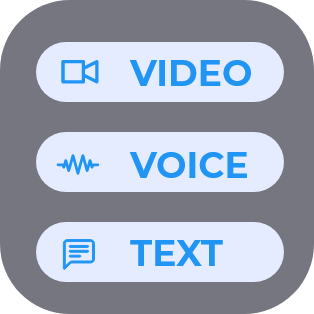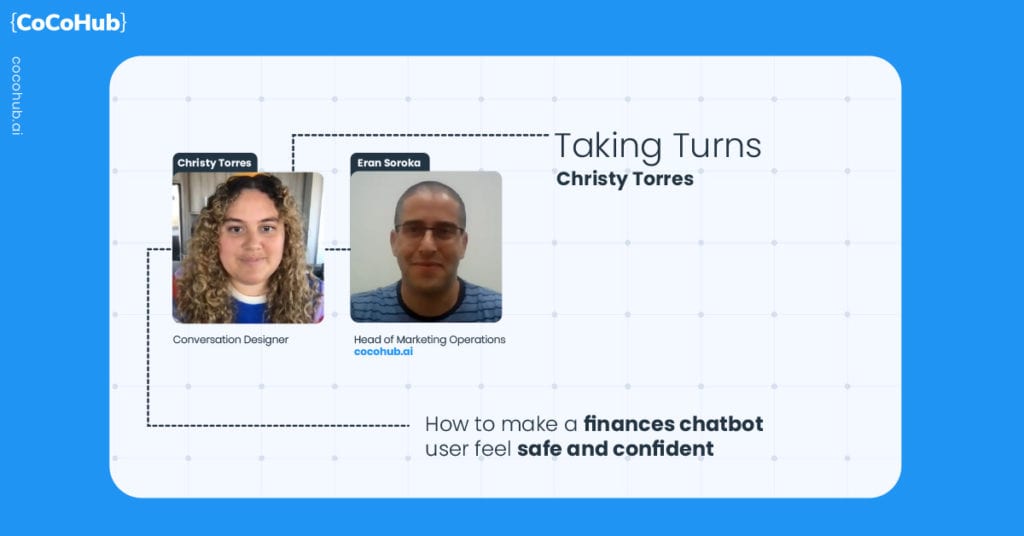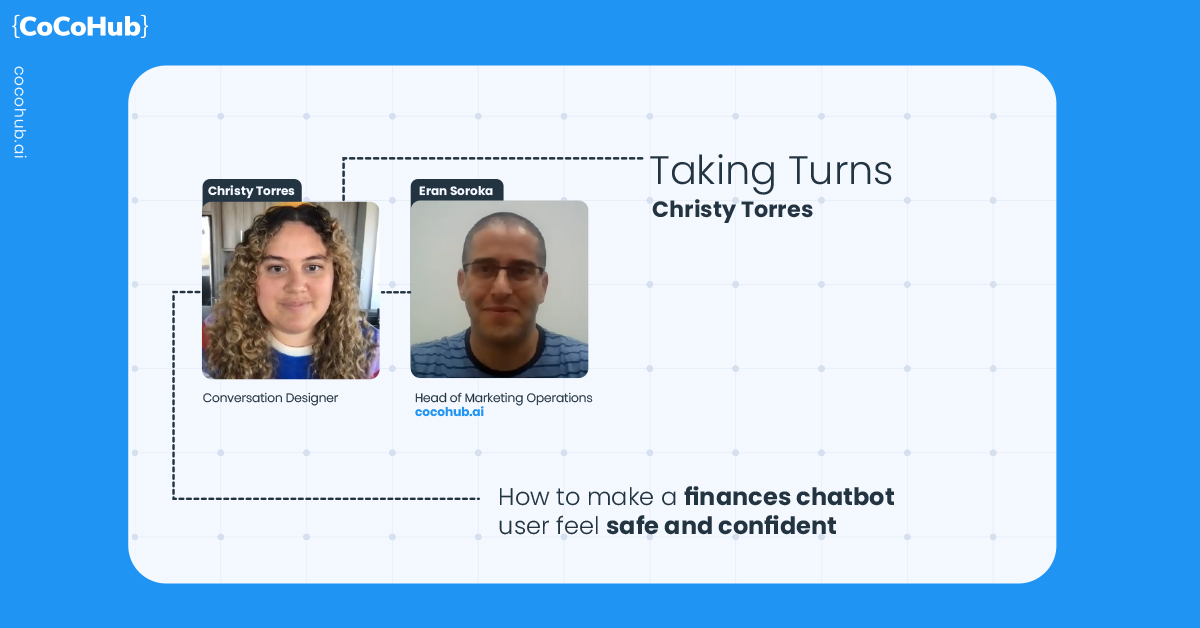As the world still struggle with different aspects of dealing with Covid-19, one thing is crystal-clear: The financial bot is here to stay. Banking and finances went online, and even if branches are re-opened – they’re not going back. As creating better remote financial services became crucial, somebody needs to make it happen; Enter people such as Christy Torres.
Coming from digital marketing and CSM background, Torres is operating in the financial space for the last 4 years. Now, in the 29th episode of Taking Turns, she explains aspects of creating an efficient financial bot, talking about her experience – and reveals some funny case which was a bit… tricky.
How did you get to conversation design?
Purely on accident. Previously I was working as a digital marketer, focusing on content strategy. Back then, I was freelancing with different tech startups to help them create content across different channels. Then, one client asked me if I’d be interested in helping them design a voice for a chatbot for their mobile app. So that’s how I got started.
What best practices do you bring from your previous role as digital marketer and CSM to the current role?
Since conversation design is so heavy on content, I bring a lot of those best practices with me. So anything that is engaging or that I know will allow the user or the end user to really feel connected to the technology – I try to incorporate into my designs. For instance, you can do different things in the way that you speak, the language, the conversation structure. How long, how short, when you present things that you can incorporate to help people feel more connected.
What is the project or chatbot that you’re most proud of?
Actually, I’m really proud of a lot of the work that I’ve done. I’ve been focused mostly in the financial space, things related to personal finance. So I really enjoy breaking down information in a way that is easily digestible for the person who’s going to consume it.
Previously, working for a startup, we were taking different personal finance concepts into a financial bot. There, they could break down information, help educate the person on what it was that they needed to do. Then, they kind of nudge behavior using behavioral economics. That was really fun. Besides that, I also really enjoyed incorporating different pieces of data and information to personalize the experience. So being able to offer stuff that you couldn’t find in other places, we could really make you feel like the financial bot or voice assistant is helping you in a way that you haven’t been able to do before.
Previously on Taking Turns | To the full playlist
Tess Tettelin knows how to handle multilingual bots
Janaina Pereira with a tip for banking bots
Jeanna Isham brings the right sound to your conversational experience
How hard is it to create trust between the customer and the bot, especially in finances? And what’s the best way to tackle this challenge?
Early on, one of my clients were one of the first people to market in Ireland to provide a finance app. So we faced that challenge a lot, because people in Ireland, since they hadn’t had other products or services that mimicked what we were doing. As a result, they felt very hesitant to use the app. Especially when it is asking you to connect your bank account or give sensitive information, so the APIs can pull the data that’s necessary to really personalize the experience.
So we really had to learn how to present our product as secure. And we have all of the necessary barriers and things that make you feel safe and show the industry standard for security that we had also meant that. Actually that became pretty basic across the board in the space, especially with banking. Everyone follow the same encryption method and all of that, to really make the end user feel safe. As it becomes more common, the user becomes more comfortable, and they’re less hesitant.
Now that more things are available, it’s becoming more common. Especially during the pandemic, where people are using digital banking a lot more heavily, they are used to it. So it’s not as big as the barrier as it was before.
Really? That’s very interesting, because one of the things that people are telling me is that people will never buy from a chatbot, like, not big things, maybe.
I think they’re getting used to getting access to their account information. As far as purchases, that’s a whole other game.
So there are a lot of agents in the financial space that have, like, a buffer where the financial bot will transfer you to a human representative before doing any hardcore tasks for you.
And that’s pretty much where we’re at.
What’s the one thing every good bot or voice assistant must have in your opinion, especially in finance chatbots?
Really, it depends on the space that you’re in and who you’re trying to service. At the end of the day, though, automation is the key across all industries. Because at the end of the day, the point of the virtual assistant or the chatbot, is to make your life easier.
So the more that they can do for you and take sort of tasks away from you, the better. Probably that’s the most important thing.
What’s the most interesting or funny thing that happened to you as a conversation designer?
As I was designing conversations for different markets and different countries, it was doing the localization and realizing that even though two countries may speak the same language, the same word could be interpreted totally different. For example, when I was writing conversation experiences for the Irish market, I used the word “Tricky”. Then, Irish users thought that that was a very negative word and they didn’t like it at all. So I had to go and change a lot of the experience. Sure, it was considered humorous for our U.S users and they thought it was funny and they got the joke. However, in Ireland they were like, ‘This is too much, we can’t do it’. So I thought that was pretty funny.
You’ve been in this field for a couple of years or more. If somebody wants to become a conversation designer, what tips or advice would you give him or her?
First of all, I’d say – just start getting involved. As the pandemic became a larger issue for the world, so many events went online and everyone started engaging virtually. As a result, that really helped closing the gap between the communities that were really separated by the ocean and different continents. So there’s so many online events that you can go to, to hear from different people, to learn from them.
Then, as different events hold panels, you’ll see who’s in the space. Who’s doing what, what areas are they doing it in. Whether you just attend those events and ask questions and try to connect with those people, everyone is so friendly and super willing to help. Especially if you sound interested and invested and you’ve done your research, and you can tell that you’re very passionate about this space, they’ll be willing to meet with you and answer your questions.
Can you tell us more about your work nowadays, as a financial bot specialist?
So I’m still working with clients in the financial space. There, I’m working to try and build experiences that help to ease the burden of having that anxiety or stress around money or anything that’s related to the finance.
During an ongoing project I’m really excited about, we’re going to expand the access of the assistant across different channels. Also, I’m doing a lot of user testing to see how people react to things, what’s going to stick, what’s not. Since I love exploring and seeing what my assumptions, how they perform, on the market in real life, and whether or not I was right or wrong or learning different perspective – that iterative process is fun for me.
Give us one forecast for the future of conversational AI and chatbots, maybe in finances, or in other fields.
Although voice is really hot right now, I don’t think that the text interface or the chat interface is totally dead. As more multimodal conversation design experiences become available, there’s going to be like a multiple kind of experience. There you’re talking, you’re seeing, you’re viewing, you’re chatting – everything moves together, and it’s seamless.
As soon as we get to a point where we really land that automation piece, it’s going to fly super-fast. Right now, in this space, the technology that exists is trying to get there where everything is seamless. But the rest of the technology outside of conversation design isn’t caught up to what the demands are.
Even though we want to automate everything, we can’t. We don’t have access to the APIs or the pulling information or connecting things together in the background, to be able to do things seamlessly. Once we kind of get to that point, it’s going to be incredible and kind of seamless. Everyday, in everyone’s lives, you’re just going to be used to using everything, which will be really cool.
More Compelling CoContent
How to create an FAQ bot in cocohub?
Do you know how to invite a chatbot to Google Meet?
How to give your chatbot a face on Zoom?
What is Wizard of Oz testing? And Omnichannel? Check out our dictionary
Next time, another episode of Coming To Terms with Miri is coming your way! Hungry for more? Join our newsletter | Follow us on YouTube | LinkedIn | Twitter | Facebook | Instagram | Or join our communities on Discord & Meetup












